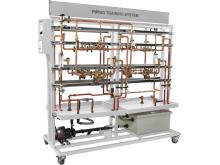Equipment Set TP 47220: Basic Dimensional Metrology (Brand)
47220Gallery


Description
Essential skills for several trades
Proper selection and adequate handling of common measuring instruments such as tape measures, rules, protractors, calipers, micrometers and various gages can be challenging for beginners in dimensional metrology. This is even more the case when various types of reading scales and systems of units must be understood.
The basic dimensional metrology equipment set offers a structured, systematic introduction to concepts, instruments, and techniques related to dimensional metrology. Developing skills in interpreting technical drawings and making measurements is particularly important for machinists, CNC machine operators, millwrights, and workers involved in quality assurance activities.
Realistic experimentation
Through hands-on activities, the basic dimensional metrology training package enables instructors to efficiently convey the fundamental knowledge and know-how related to linear and angular measurements. Comprehensive courseware offers a large range of exercises and projects arranged in a sequence of increasing complexity. This approach allows students to reinforce and expand their skills in a fluid way and improves transferability to the workplace. Guided exercises build basic know-how and confidence; realistic projects develop decision-making skills.
Build expertise with the right equipment
This package includes semi-precision and precision measuring instruments commonly used in the industry for metrology purposes. The value of the training package is based on the parts used for measurement activities. These parts − from simple to intricate ones − represent real-life consumer and industrial components and are carefully designed to challenge students’ metrology skills in a variety of realistic scenarios. They allow the tools to be used to their fullest extent while providing multiple measurement opportunities. Parts are manufactured to ensure repeatability from one equipment set to another.
Also included are a set of master rings and a gauge block that allow students to self-assess their expertise and build confidence. They also develop their ability to perform routine field checks to detect conditions that may impair the accuracy and performance of instruments, a key aspect of metrology.
This helps them develop competencies in performing routine tests to identify conditions that could affect the accuracy and quality of the measuring equipment. This is an essential aspect of measuring technology.
Note
Whether you choose the Standard version which includes brand-name measuring instruments such as Mitutoyo and Starrett or the Value version with generic versions, the learning outcomes and student manuals and instructor guides remain the same.
Enhanced learning experience through Augmented Reality
Students use the free Festo Didactic AR app to visualize the features of parts in 3D from their home with smartphones or tablets. The app is compatible with Apple and Android devices.
Included parts
• TV bracket
• Joist hanger
• Hydraulic fitting
• Sensor brackets
• Pump shaft
• Bearing cover
• Lock pins
• Hydraulic disc brake calipers Included measuring instruments
• Tape measure, steel rules, protractor
• Digital, Vernier and outside calipers
• Depth and thickness gauges
• Screw pitch gauges
• Digital and Vernier micrometers with stand
• Set of thread measuring wires
• Small holes gauges
• Telescoping gauges Learning outcomes
• Explain the concepts of metrology and measurement
• Differentiate and convert between SI and US customary units
• Define the concepts of precision, accuracy and error
• Explain the difference between calibration and field check
• Describe and read various types of instruments and scales
• Describe proper use of instruments
• Perform field check of instruments
• Perform measurements
• Identify the standard sizes for drawing sheets
• Recognize the main types of lines used in technical drawings
• Identify the various views on a technical drawing
• Explain the difference between orthographic and pictorial projections
• Explain the difference between first angle and third angle projections
• Identify and interpret tolerances on technical drawings
• Explain the importance of standard tolerances and fits in assemblies
• Explain what a precision transfer measuring instrument is
• Interpret tolerance codes for metric tolerances based on the standard ISO 286
• Find limit deviations for metric tolerances using the tables provided in the standard ISO 286-2
• Find limit deviations for tolerances in inches using the tables provided in the standard ANSI B4.1
Additional equipment required to perform the exercises (Purchased separately)
| Qty | Description | Model Number |
|---|---|---|
| 1 | Campus Licence, Basic Dimensional Metrology | 81220-9 |















